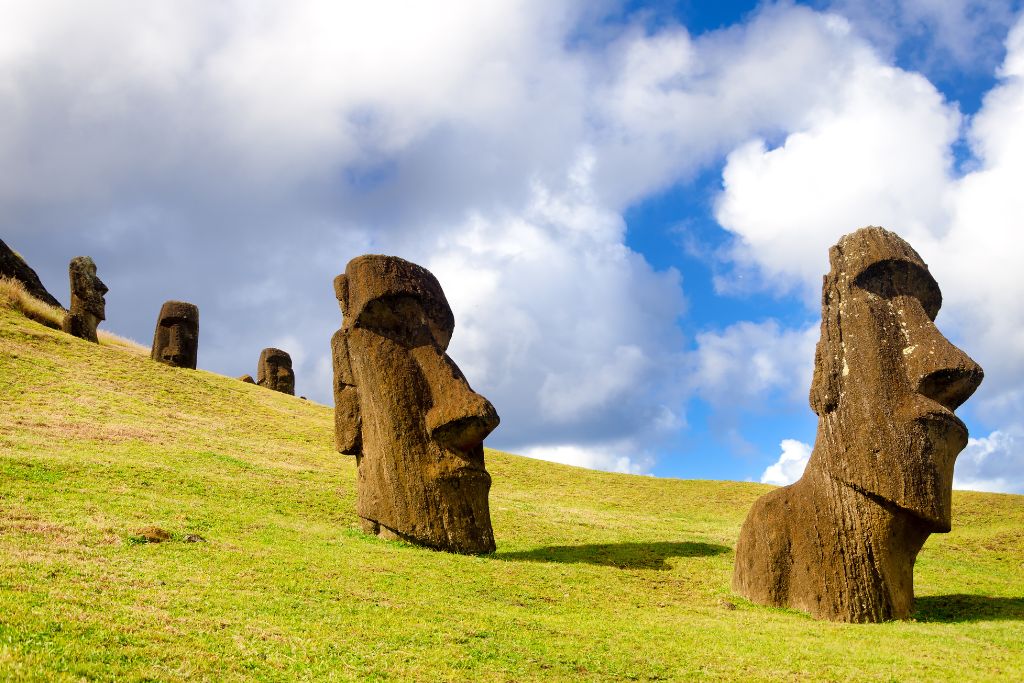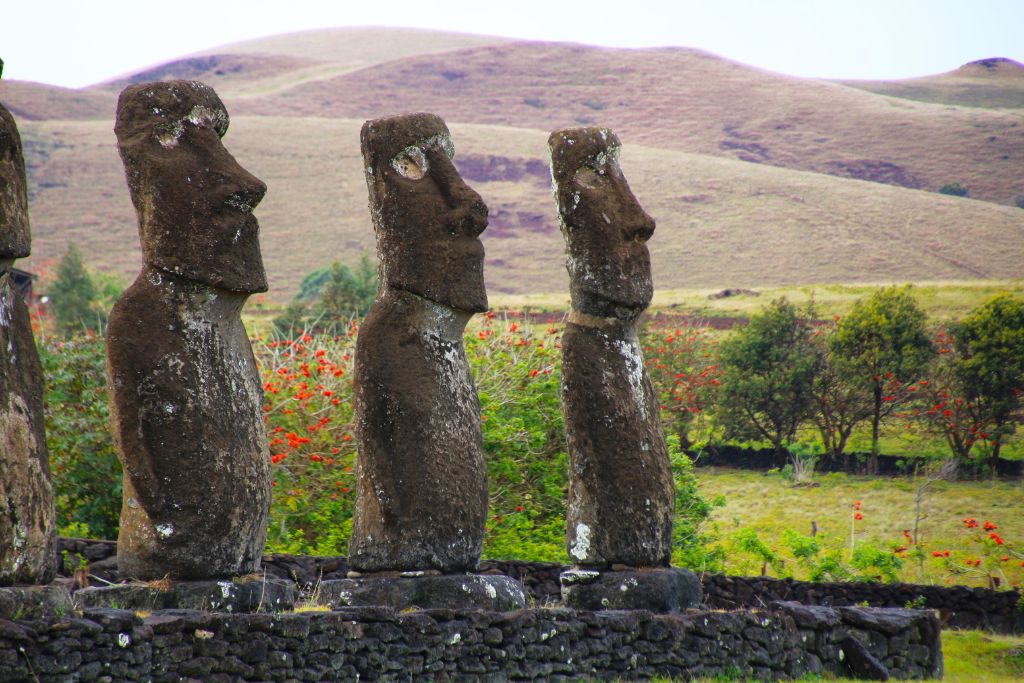12 Things You Didn’t Know About The Moai Statues
Posted by Maris on 21st Aug 2023
The Moai statues are located on Easter Island, also known as Rapa Nui by the indigenous inhabitants, and are frequently referred to as the Easter Island Heads. The Rapa Nui people carved these iconic monolithic statues between 1250 and 1500 CE, representing the live faces of the local population’s deified ancestors.
On the island, 887 Moai statues have been uncovered, with the largest towering 33 feet tall. Many mysteries surround these amazing sculptures, but scientists and archeologists have discovered a few facts about them. Check out these ten facts about the Moai statues that you probably didn’t know.
Each Moai took a year to build.

Because the Moai are such magnificent statues, so they attract thousands of tourists annually. They took some time to complete, as with anything excellent. According to Just Fun Facts, each statue took around a year to create by teams of five to six men using basalt stone hand chisels.
There are at least 887 statues.
There are 887 known statues, most of which are sculpted from volcanic ash known as tuff. Others are made of red scoria, trachyte, and basalt. They range in height from less than five feet to 33 feet.
One statue stands out from the rest.

The characteristic chiseled features of the Moai set them apart from other statues. But there is one Moai who stands out from the crowd. While the most of the statues have elongated features, the Moai known as Tukuturi is significantly more human-like.
Tukuturi is a considerably smaller statue than the others and looks to be kneeling. Tukuturi, according to Atlas and Boots, was likewise carved from Pua Pura stone and then transported to Rano Raraku, where the others were sculpted. There’s always one outlier!
The Statues Were Once Destroyed
Many elements about the Moai are still unknown to anthropologists. They agree that the sculptures were destroyed at some point in time by opposing clans. This is reported to have happened around the 1700s. Rebellions and riots erupted on the island, probably as a result of deforestation and diminishing supplies, prompting clans to attack one other’s sculptures.
By 1868, there were no standing monuments on the entire island. Some remained on Rano Raraku’s slopes, though they were partially buried.
It is still debated how the statues were moved.

Most of the Moai were carved over 900 years ago, when the native Rapa Nui people did not have the luxury of modern infrastructure. Archeologists are still perplexed as to how the statues were hauled 11 kilometers across the island without using wheels, cranes, or strong animals.
According to some ideas, the islanders utilized wooden sleds, ropes, and log rollers. Given that the heaviest Moai weighs 86 tons, it would have taken significant force to move them.
Almost all of the statues face away from the sea.
Aside from their distinguishing appearance, the Maoi are all identical in that they all face inland, away from the sea. At Ahu Akivi, there is one statue that faces the ocean. This is a sacred site for the locals, which may explain why the Moai faces in the opposite direction.
Facts According to legend, most sculptures face the villages rather than the ocean because the Rapa Nui people believed the statues watched over and protected them.
They’re not only Easter Island heads, but entire bodies as well.

The Maoi are famous emblems of Easter Island, also known as Rapa Nui in its original tongue. Many individuals are unaware that the statues have whole bodies because they are frequently depicted as heads without bodies in popular culture. The most iconic pictures of the statues show them buried up to their necks, giving rise to the widespread belief that they are “Easter Island Heads.”
Due to excavations, archeologists have known that the statues had bodies since 1914. Even still, the idea that they are only heads prevails.
Some statues wear hats.

Most people are astonished to learn that certain Moai sculptures have hats on their heads, despite most images of them showing them without any form of headpiece. According to My Traveling Circus, these are known as Pukao.
Unfinished Statue: Would have been 21 meters (69 feet) tall and weighed 145-165 tons.
The hats could be decorated hair or headdresses, which were popular among native chiefs. While some individuals believe the caps signify hair, others say they represent power. There is also the possibility that they were just a part of formal clothing during the time they were carved.
Tourists are strictly prohibited from approaching the statues.
It only takes one rotten egg to ruin everything for everyone else. After a Finnish visitor severed one of the Moai’s ears in 2008, even more restrictions were imposed on people visiting the statues.
The 26-year-old Finnish tourist fled with a piece of the monument in his hand, but he was apprehended by a local, who reported him to the police. After being placed under house arrest, he issued a public apology and was fined $17,000 USD. Today, tourism on Easter Island is equally limited.
Several superstitions surround the statues.

The Rapa Nui people had a number of superstitions that controlled their interactions with the statues. They famously thought that it was for a good reason when a Moai fell, and that the statue should never be rebuilt. This is why many Moai were left unfinished.
Similarly, it was thought that their spirits were aroused when the Moai were given eyes. After bestowing coral eyes on the statues, the islanders could convey their energy onto the humans.
The Statues Could Have Been Created As A Reaction To Disease
According to one idea, the Moai were made as an antidote to leprosy, which had spread to other Polynesian islands. After witnessing the disease’s devastation, the Rapa Nui people erected statues that they believed could reverse the damage.
This is why the Moai statues have over-corrected characteristics that are usually the polar opposite of leprosy symptoms. The noses on the Moai, for example, are prominent and stylised, which could be a reaction to seeing torn nasal cartilage as a result of leprosy.
Oral History of How They Were Moved

How did a stone-age population build the gigantic Moai statues, some weighing up to 14 tons? How this was accomplished is still up for question, but a number of thinkers have experimented with it. How did they manage to move them with only stone, wood, rope, and human muscle?
According to oral traditions and folklore, they were moved by “mana” or divine power. Those possessing mana might also command the statues and move them into position. The most likely answer is that it was done by aliens, similar to how aliens built the Pyramids (jokes). On pbs.org, you can find a list of theories about how they were transported.
They are Chilean.
Easter Island is a Polynesian island, like New Zealand, Tahiti, Hawaii, and Tonga, and it is a Chilean special territory (the only part of Polynesia to be a South American country). The island is known as “Isla de Pascua” in Spanish and has a population of approximately 8,000 people.

